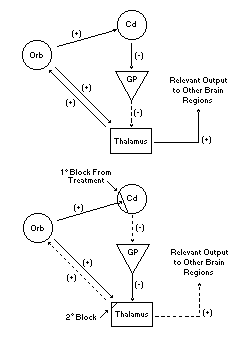
| FIG. 3 |
 |
| Proposed model of brain system dysregulation that may mediate the symptom expression of OCD. In the symptomatic state (top) worry output from the medial orbital region (Orb), largely glutimate, may be driving OCD-relevant circuits in the anterior medial ventral regions of the head of the caudate nucleus (Cd), and thus increase inhibitory GABA output to relevant regions of the globus pallidus (GP). This would reduce inhibition of the thalamus by GABA, making it vulnerable to being driven (glutimate) by the orbit as well. The excitatory connections between thalamus and orbit make this a potentially self-sustaining circuit, and thus difficult to break (fixation). With effective treatment (bottom), however, increases in filtering functions in the Cd may reduce its inhibitory output to the GP, which in turn would increase inhibitory output to the thalamus. This would result in an uncoupling of this fixed worry circuit and allow the patient to more easily terminate OCD behaviors. Arrows indicate the effect of stimulating one brain region on the rate of neuronal firing in the other; +, excitatory output; -, inhibitory output; and – – –, reduced effect. From Baxter et al. (15). |
| Back to Chapter |
published 2000